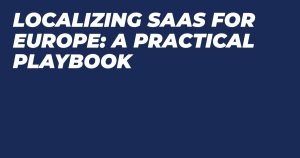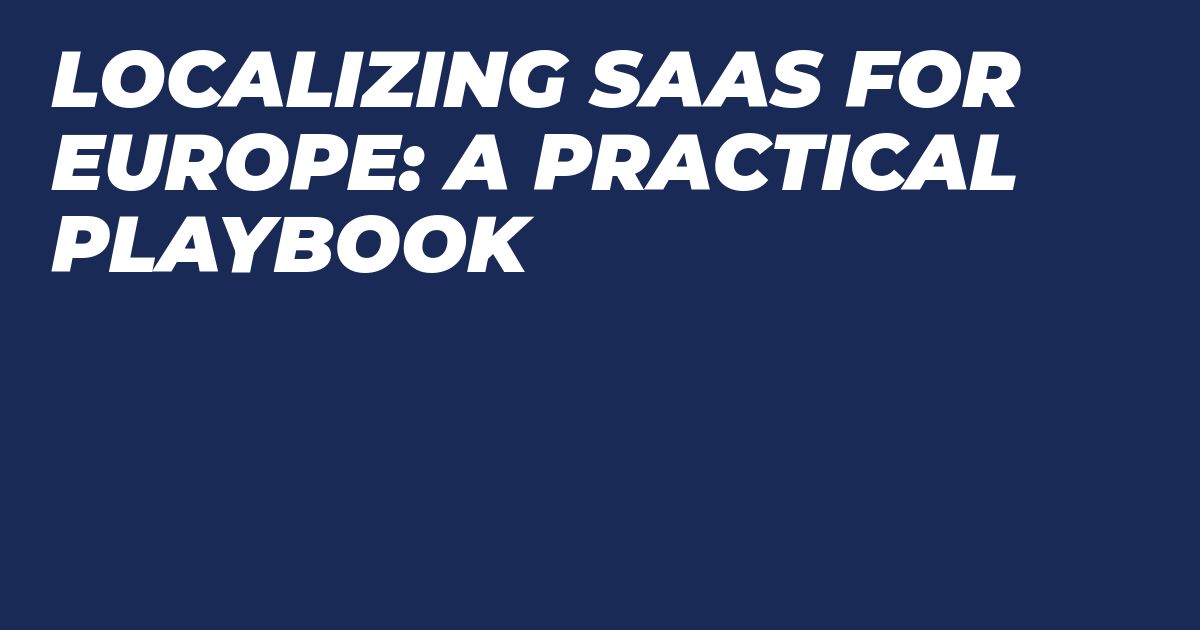If users cannot read your product, they will not trust it. That simple truth drives growth and international expansion for SaaS teams in Europe. When your UI and help centre speak French, German, Spanish, Italian, and Dutch with clear tone and local formats, effective localisation builds trust, sign-ups feel safe, onboarding is smooth, and support tickets fall. Strong localisation also helps you meet EU user expectations and reduces support load by boosting self-serve help.
This guide outlines a practical localisation strategy, including workflow, language tips, help centre best practice, QA, and measurement. You will learn what to localise first, how to avoid rework, and where business translation and interpretation services fit. London Translations is a trusted partner for complex projects and live interpreting across product, marketing, and support.
Why localising your SaaS UI and help centre for France, Germany, Spain, Italy, and the Netherlands pays off
Localisation is not only about words; it is about enhancing user experience (UX). When users see their language, their number formats, and familiar tone, they act faster and ask fewer questions. That drives activation, lowers ticket volume, raises NPS, and protects renewals. Effective SaaS localisation delivers these benefits by tailoring content to cultural nuances, boosting efficiency across your operations.
- Familiar formats reduce friction. Show dates, times, numbers, and currencies as users expect in each market. A German invoice with a decimal comma, proper currency formats, and DD.MM.YYYY date feels normal and safe.
- Local help content cuts confusion. When users search your knowledge base in their own words, they find answers faster. Search success goes up, and tickets go down.
- Privacy and consent need careful localisation. EU users expect clear wording on cookies, consent, and data processing. Clumsy language causes drop-offs and complaints.
- Business translation and interpretation services matter across the journey. Product copy, help articles, sales demos, onboarding webinars, and research interviews all rely on accurate messages and consistent terms.
Quick wins in localisation usually come from core UI strings and top help articles. Start with buttons, menus, onboarding flows, error messages, and system emails. In the help centre, localise the top 20 articles by traffic and tickets. You can expand from there, with localisation streamlining future updates for greater efficiency.
For larger product scopes or multi-team alignment, explore our SaaS localisation services to plan an efficient rollout.

What to localise first for fast wins
Prioritise the UI (User Interface) elements your users touch every day:
- Navigation labels and menu items
- Buttons, CTAs, and tooltips
- Error and empty-state messages
- Onboarding screens and checklists
- System messages: password reset, 2FA prompts, billing notices
- Transactional and onboarding emails
In your help centre, start with:
- The top 20 articles by page views and ticket volume
- Core setup, billing, and account management guides
- Feature adoption articles that teach key workflows
Match visuals to the language. Localise screenshots, diagram labels, and alt text. A Spanish article with English screenshots confuses users, so keep UI and images in sync.
Compliance and privacy basics for EU users
To ensure regulatory compliance, GDPR-related texts must be clear and correct in each language. Translate cookie consent, data processing notices, privacy policy links, and legal footers. Localise consent buttons and cookie categories so users understand their choices. Run a legal review after translation, and adapt payment methods to local expectations for seamless transactions.
Common formatting needs:
- Dates: day first is common, for example DD/MM/YYYY or DD.MM.YYYY
- Numbers: decimal comma in many markets, dot as thousands separator
- Time: 24-hour time improves clarity in most EU markets
How business translation and interpretation services support product and sales
Expert linguists support product localisation to keep product copy, sales decks, and help articles aligned. They maintain tone and terminology across touchpoints. Live interpreting supports sales calls, onboarding workshops, and user research interviews, so teams gather accurate insights and close deals without confusion.
London Translations can provide a single team across product, marketing, and support. Terms stay consistent, users feel confident, and teams move faster with fewer rewrites. For software-heavy projects, our software localisation solutions keep your UI, docs, and help content aligned.
Build a localisation-ready SaaS workflow that ships on time
Localisation slips when the workflow is vague. A clear flow helps teams ship high-quality updates in every sprint.
- Prepare for i18n first to avoid rework later.
- Set style guides and a term base for tone and key terms.
- Write source content that is easy to translate.
- Use tools and QA loops to catch errors early.
- Design for text expansion and readability across devices.
Internationalisation basics engineers should ship first
- Externalise all strings in resource files.
- Use stable, descriptive keys.
- Support UTF-8 and right-to-left readiness, even if not needed yet.
- Handle plural forms properly with locale-aware rules.
- Avoid hard-coded dates, times, and currencies. Use locale libraries.
- Keep placeholders clear and protected, for example {count}, {name}.
- Do not concatenate strings. Keep variables separate to preserve grammar.
Style guides and term bases that keep brand voice consistent
Define tone, formality, and glossary entries per language. This guides translators and speeds reviews, while ensuring brand consistency across markets.
- Formality: vous or tu in French, Sie or du in German, usted or tú in Spanish, Lei or tu in Italian, u or je in Dutch.
- Keep product and feature names consistent. Decide what stays in English and what gets localised.
- Set preferred verbs for CTAs, for example “Start trial” vs “Begin trial”.
- Use inclusive language. Avoid gendered terms when not needed.
- Agree error tone: direct, polite, solution-first.
Source text hygiene that speeds up translation
- Write short sentences in active voice.
- Avoid idioms and jokes that do not travel.
- Put one idea per string. Avoid multi-sentence blocks where possible.
- Add context notes and screenshots for tricky UI.
- Mark variables clearly, for example {count}, and explain what they hold.
- Keep punctuation and spacing consistent so translators can match local rules.
Translation workflow and quality checks that scale
Use a lean, repeatable flow to support effective localisation:
- Prepare strings with context.
- Translate and edit with terminology and translation memory in a translation management system (TMS).
- Run automated QA for missing variables, double spaces, and length checks, even when incorporating machine translation (MT) for initial drafts.
- Review in context in a staging build.
- Sign off with a checklist before release.
Keep a feedback loop for continuous localisation. Feed support tickets and analytics back into the glossary and style guide. Over time, this removes repeat issues and speeds up delivery, enhancing overall localisation quality. For high-stakes content, our Professional business translation services add expert editors to protect tone and accuracy, ensuring polished localisation outcomes.
Design for text expansion, layout, and accessibility
- Use responsive UI elements that wrap text and allow resizing.
- Avoid truncation in mobile views and tight tab labels.
- Plan for text expansion, especially for long German compounds and longer French phrases.
- Respect French spacing before ; : ! ?
- Meet WCAG standards. Keep colour contrast strong and fonts readable.
- Localise aria-labels, titles, and form hints.
- Keep line length comfortable across all five languages.
Language-specific tips for French, German, Spanish, Italian, and Dutch
These quick rules for local language localization help writers and reviewers ship clean, localised UI copy that accounts for cultural differences in formality levels, such as vous/tu in French or Sie/du in German.
French (fr-FR): formality, spacing, and decimal comma
- Prefer vous in business UI. Use tu only for very casual brands.
- Add a thin space before ; : ! ?
- Use a decimal comma and a space as thousands separator.
- Dates often DD/MM/YYYY, time usually 24-hour.
- Translate common tech terms, for example logiciel for software.
- Watch false friends like librairie vs bibliothèque.
- Keep button labels short and polite.
German (de-DE): long compounds and formal Sie
- Use Sie in formal UI. Use du only for brands with a clear casual voice.
- Capitalise all nouns.
- Expect longer words. Give buttons and tabs more space.
- Decimal comma and dot as thousands separator. Dates often DD.MM.YYYY. 24-hour time.
- Avoid splitting verbs across lines.
- Write direct, polite, solution-focused error messages.
Spanish (es-ES): accents, inverted punctuation, and neutral style
- Use neutral European Spanish. Choose usted or tú based on brand voice, many B2B products use usted.
- Include accent marks and inverted ¿ and ¡.
- Decimal comma and dot as thousands separator. Dates often DD/MM/YYYY.
- Prefer simple, clear phrasing over Anglicisms.
- Translate common tech terms where users expect them. Keep brand terms consistent across UI and help.
Italian (it-IT): polite Lei and readable phrasing
- Use Lei for respectful UI unless your brand is very casual.
- Dates often DD/MM/YYYY, time usually 24-hour.
- Check doubled consonants and elisions, for example l’app.
- Keep sentences short and friendly.
- Use common Italian UI terms. Avoid stiff calques from English.
Dutch (nl-NL): clear tone and compact wording
- Use u for formal or je for informal, based on brand voice. Many SaaS brands use friendly but direct language.
- Dates often DD-MM-YYYY, 24-hour time.
- Favour short sentences and active voice.
- Expect compound words. Allow more space for labels.
- Keep punctuation simple. Do not add accents that Dutch does not use.

Localising your help centre and support experience
A localised help centre earns trust and deflects tickets. It shows users you are committed to their success, and it gives them answers at any hour. Effective localisation in your help centre builds confidence, while thoughtful structure ensures users find what they need quickly.
Structure and search that reduce tickets
- Organise articles by user tasks, not internal teams, to enhance the overall user experience (UX).
- Use short, clear titles that match how users search.
- Add local keywords and synonyms to headings and summaries for better SEO and localisation.
- Keep steps numbered and screenshots current.
- Link related articles so users complete tasks without opening a ticket.
Localisation here means tailoring content to reflect regional nuances, which further reduces support volume by making resources more relevant.
Screenshots, diagrams, and alt text in the right language
- Localise UI labels inside screenshots and diagrams.
- Translate callouts and annotations.
- Provide alt text in the target language for accessibility and search.
- Store layered source files so editors can update text fast.
- Update visuals whenever the UI changes to avoid mismatched guidance.
Video, subtitles, and voiceover that users can follow
- Provide subtitles in all five languages.
- Keep on-screen text short and readable.
- Use clear, neutral narration if you add voiceover.
- Provide a transcript for search and accessibility.
- Adjust timings for longer phrases, especially in German and French.
Chatbots, AI answers, and handover to humans
- Train intents per language. Do not rely on raw AI translation for training data.
- Add local synonyms and common misspellings.
- Offer a quick route to a human when confidence is low.
- For complex calls, plan interpretation so issues are resolved first time.
Multilingual support and interpretation on live calls
- Staff core hours with native-speaking agents for reliable local support.
- Use on-demand interpreters for peaks, demos, and onboarding.
- This mix helps users feel heard and reduces repeat contacts.
- London Translations provides interpreters who learn your product. Accuracy goes up, and users feel confident they are understood.
QA, rollout, and measuring success across five languages
A simple plan keeps quality high and releases on track. Focus on the checks that protect the user experience.
Linguistic and functional testing that catches issues early
- Run in-context reviews in a staging build to ensure localisation accuracy.
- Use pseudo-localisation to find hard-coded strings and layout risks.
- Test forms, validation, emails, and error states in each locale as part of the localisation process.
- Check links and search behaviour inside the help centre.
- Log issues in a shared tracker and feed patterns back into the glossary to refine ongoing localisation efforts.
Pilot by market, then expand with confidence
- Start with one or two target markets where you already have traffic.
- Measure activation, feature adoption, and help centre search success.
- Gather user feedback from surveys and support.
- Apply lessons to the next markets.
- Keep release notes localised so users see steady progress.
Metrics that show the value of localisation
Track outcomes by locale, including in the European market:
- Sign-up to activation rate and time to value, incorporating checks for local payment systems in billing notices
- CSAT and NPS
- Ticket deflection and help centre search success
- Churn, renewal, and upgrade rates
- Article views against ticket volume for the same topics
Use these results to plan the next set of articles and UI updates, demonstrating the impact of localisation. Share wins with product and leadership to sustain momentum.
Budget, timing, and roles
Costs depend on word count, update cadence, multimedia needs, and reviewer time. Plan roles:
- Localisation PM
- Engineers with i18n skills
- Product writers
- Translators and editors
- In-market reviewers
A simple 90-day plan for SaaS localisation:
- Weeks 1 to 3: i18n readiness, style guides, term base
- Weeks 4 to 7: localise core UI, system emails, top 20 help articles
- Weeks 8 to 10: in-context review, functional QA, visual updates
- Weeks 11 to 13: launch to pilot markets, measure, iterate
When to partner with London Translations
Consider a partner when you have high-impact UI changes requiring product localisation, legal or compliance texts, live customer events, or tight timelines. London Translations provides business translation and interpretation services that keep your product copy, help content, and live conversations aligned. If you want tailored support for software, apps, and help centres, speak with our team to plan a rollout that hits your dates and protects quality.
Conclusion
Here is the simple plan. Prepare your product for i18n, define voice and key terms, handle localization for core UI and top help content, test in context, then measure and improve. Based on market research, focus on French, German, Spanish, Italian, and Dutch to unlock real growth across Europe through effective SaaS localization. With expert business translation and interpretation services, your rollout will be faster and smoother. London Translations is a dependable partner for quality localization, speed, and a consistent user experience across every touchpoint, including localizing marketing efforts. Ready to ship a local experience your users will trust, one that supports your broader marketing strategy? Reach out and let’s build it together.

